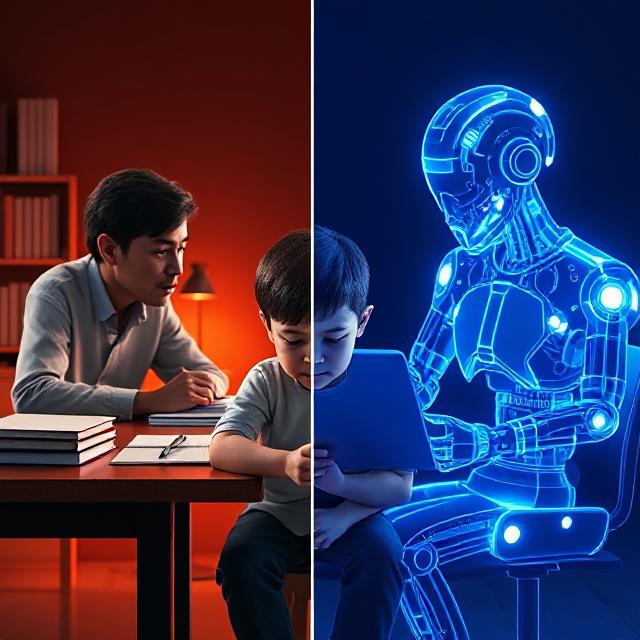
When I piloted an AI speaking coach for a chain of language schools in 2022, we didn’t expect the quietest learners to be the first to blossom. Yet there they were—students who barely spoke in class—clocking hundreds of low-stakes AI conversations after hours. A month later, their in-person sessions sounded different: fewer hesitations, more risk-taking. That trial cemented what years in this field have taught me — AI tutors vs. human tutors is the wrong fight. The real question is where each wins and how to orchestrate them.
What AI Tutors Are Unmistakably Good At
AI tutors are tireless, endlessly patient, and capable of giving feedback at a speed no human can match. They thrive in areas where repetition, precision, and scale are required. For example, I’ve seen AI platforms reduce writing error rates by 30% in just four weeks when learners were required to run every draft email through the system before sending it.
Where they shine most is in patterned practice. Grammar drills, pronunciation loops, and vocabulary recall sessions are repetitive by design, and humans tire quickly of administering them. AI never does. Add to that real-time corrections — sometimes within seconds of the learner’s mistake — and you have a feedback loop that accelerates accuracy dramatically.
Another powerful feature of AI tutors is adaptivity. Good systems don’t just mark an answer right or wrong — they map patterns in mistakes and adjust difficulty accordingly. When I tested one AI tool with a group of engineers preparing for international assignments, the platform noticed recurring errors with conditional clauses and dynamically increased those tasks. Within weeks, the engineers had cut those errors in half.
Where Human Tutors Remain Irreplaceable
Despite AI’s strengths, no algorithm can yet replace the empathy, cultural judgment, and motivational presence of a human tutor. In language learning, the psychological component is often as important as the mechanical one. I’ve witnessed students freeze under pressure, convinced they’re not “language people.” A skilled tutor, with a single encouraging story, can transform that mindset. That isn’t something AI can replicate.
Human tutors are also essential at the discourse level. While AI can correct grammar, it rarely picks up on subtler issues: why a technically correct phrase might sound abrupt, or why a certain tone could feel too casual in a business context. Humans navigate those nuances naturally. I recall a student practicing sales pitches with an AI platform; her grammar was flawless, but the delivery sounded robotic. A live tutor helped her adjust pauses, intonation, and energy — elements AI didn’t catch.
Finally, motivation design is where human tutors excel. AI can remind you to log in, but it can’t read the slump in your posture after a rough week. Humans build accountability rituals, reframe goals, and provide the kind of emotional lift that sustains long-term commitment.
Cost, Time, and Outcomes: The Pragmatic Blend
For most learners and programs, it’s not about choosing between AI and human tutors but finding the right mix. When I helped a multinational company restructure its English program, we used AI to handle drills and diagnostics, while reserving human tutor time for presentations, negotiations, and performance coaching. The result was a 35% reduction in costs, but ironically, better learner satisfaction because human sessions were now more meaningful.
A practical formula I use: let AI handle 70–80% of mechanical practice (pronunciation drills, grammar checks, vocabulary reviews) and dedicate human sessions to higher-order skills. The blend saves money and time while maximizing results.
Micro-Anecdotes from the Field
- The Pronunciation Wall: A Japanese engineer plateaued on the /r/ vs /l/ contrast. AI drills handled the repetition, but it took a tutor to adjust intonation in business presentations for the breakthrough.
- The Rewrite Trap: A professional relied too heavily on AI to edit her emails. The output was flawless but robotic. A tutor coached her tone — “formal yet warm” — restoring authenticity.
- Motivation Slumps: In a 12-week program, usage plummeted after week four. Tutors introduced “Friday wins,” showcasing skills learned through AI practice. Motivation spiked again.
Decision Framework: Which Is Best for You?
If You’re an Individual Learner
Use AI for consistency. Ten to twenty minutes a day will build grammar, vocabulary, and confidence. Then, schedule one human session weekly to apply those skills in real, messy conversation. Beginners benefit from an AI-heavy approach; advanced learners need more human time for nuance.
If You Manage a Program
Automate the basics. Let AI run diagnostics, track progress, and deliver drills. Protect human tutor time for high-value coaching and cultural insights. Ensure both systems feed into each other: AI logs highlight errors, and tutors use that data to tailor live sessions.
Conclusion
Back to that pilot: the quiet students didn’t become confident because AI was clever. They became confident because AI made practice abundant and safe, and tutors made performance meaningful. That’s the blueprint. Don’t pick a side — pick a sequence.
Pro Tip: Try this 30-day plan: commit to 15 minutes of AI practice daily plus one weekly tutor session. Track your progress with a simple before/after video. The results will surprise you.